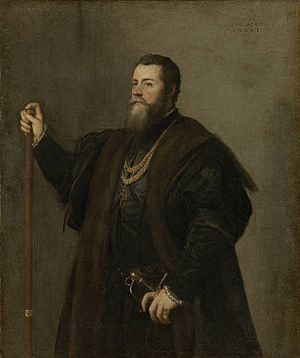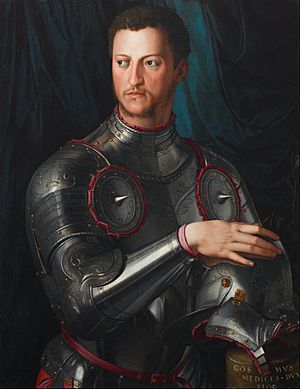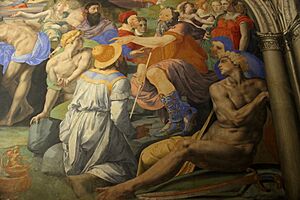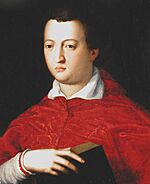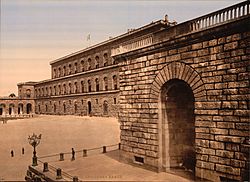Eleanor of Toledo facts for kids
Quick facts for kids Eleanor of Toledo |
|||||
|---|---|---|---|---|---|
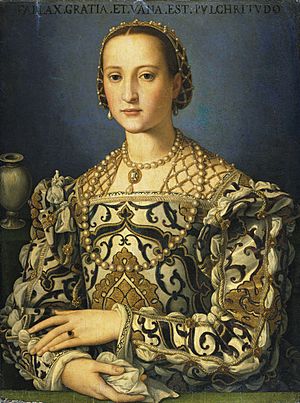
Portrait by Agnolo Bronzino
|
|||||
| Duchess consort of Florence | |||||
| Tenure | 29 March 1539 – 17 December 1562 | ||||
| Born | 11 January 1522 Alba de Tormes, Spain |
||||
| Died | 17 December 1562 (aged 40) Pisa, Duchy of Florence |
||||
| Burial | Medici Chapel | ||||
| Spouse |
Cosimo I de' Medici
(m. 1539) |
||||
| Issue see details... |
|
||||
|
|||||
| House | Alba de Tormes | ||||
| Father | Pedro de Toledo y Zúñiga | ||||
| Mother | María Osorio y Pimentel | ||||
| Religion | Roman Catholicism | ||||
Eleanor of Toledo (born Leonor Álvarez de Toledo y Pimentel-Osorio; 11 January 1522 – 17 December 1562) was a Spanish noblewoman. She became the first wife of Cosimo I de' Medici, making her the Grand Duchess of Florence.
Eleanor was a smart businesswoman. She helped pay for many of her husband's projects. These included political campaigns and important buildings like the Pitti Palace. She also acted as a regent (a ruler in place of the king or duke) for Florence when Cosimo was away. She ruled during his military trips and when he was sick. Eleanor also helped start many Jesuit churches. Some people even say she was like the first modern first lady or queen.
Contents
Early Life in Spain
Eleanor was born in Alba de Tormes, Spain, on January 11, 1522. Her father was Pedro Álvarez de Toledo, who was the Viceroy of Naples. This meant he was a very important governor for the Emperor Charles V. Her mother was Maria Osorio y Pimentel.
In 1534, when Eleanor was about 12, her family moved to Naples, Italy. They lived in the strict Spanish court there. When she was 13, a young man named Cosimo I de' Medici visited Naples. He was a page (a young attendant) and noticed Eleanor.
Marriage to Cosimo I de' Medici
A few years later, Cosimo became the Duke of Florence. He needed a wife to make his family's position stronger. He first wanted to marry Margaret of Austria, but she didn't want to. So, the Emperor offered Cosimo one of the rich Viceroy of Naples' daughters.
Cosimo remembered Eleanor. He chose her because she would create a strong connection between the Medici family and Spain. This was important because Spain had a lot of control over Florence at the time. Eleanor's father also gave her a large dowry (money or property given by the bride's family).
Eleanor and Cosimo were married on March 29, 1539, through a special ceremony where someone stood in for Cosimo. They started writing letters to each other right away. Eleanor quickly learned to read Italian.
On June 11, 17-year-old Eleanor sailed from Naples to Italy. She arrived in Livorno on June 22 and then traveled to Pisa, where she met Cosimo. They then went to Florence for their big wedding.
Their wedding was a huge, fancy celebration on June 29, 1539. The painter Agnolo Bronzino helped decorate the city. This event showed how the new Duke wanted to bring art back to Florence. Cosimo and Eleanor had a peaceful family life, which was unusual for rulers at that time. Cosimo was loyal to her throughout their marriage. Their strong family life helped make the Medici family more stable and powerful in Tuscany.
Before their marriage, the Medici family was in danger of losing its power. Eleanor and Cosimo had many children, which helped secure the family's future. Their children married into other important families, which made the Medici family equal to other European rulers.
Eleanor and Cosimo had eleven children. Here are the ones who lived to be adults:
- Francesco (born 1541): He became Grand Duke after his father.
- Isabella (born 1542): She married Paolo Giordano I Orsini.
- Giovanni (born 1543): He became a bishop and a cardinal.
- Lucrezia (born 1545): She married Alfonso II d'Este. She died at age 16.
- Ferdinando (born 1549): He became Grand Duke after his brother.
- Pietro (born 1554).
Duchess of Florence
Eleanor became a very important figure in Florence. Her husband, Cosimo, wanted the public to see his family as stable and respected. Eleanor's motto was cum pudore laeta fecunditas, which means "happy fruitfulness with chastity." This referred to her many children and her loyalty in marriage.
Eleanor became very influential in Florence's politics. Cosimo often asked for her advice. He trusted her political skills so much that he made her a regent when he was away. This meant she ruled Florence in his place. Eleanor was regent during Cosimo's military campaigns in 1541 and 1543, when he was sick from 1544 to 1545, and during the war for Siena (1551–1554).
Business and Politics
Eleanor was very interested in business, especially farming. She owned large areas of land where grain was grown and animals were raised. She also had businesses like beekeeping and silkworm farming. She even took part in mining. Her farms produced a lot, and her goods were sent as far as Spain. Eleanor managed her businesses wisely, which greatly increased the wealth of the Medici family. She also helped poor farmers through her charity work.
At first, some people in Florence didn't like Eleanor because she was Spanish. But Eleanor made many donations to Florentine charities. She also supported Cosimo's efforts to make Florence independent from foreign control. If people couldn't get a meeting with the Duke, they could often get help by talking to the Duchess.
Eleanor was a very religious woman. She gave money to and visited many convents. She helped start the first Jesuit school in Florence. She also helped found many new churches in the city.
Supporting the Arts

Like her husband, Eleanor supported many famous artists of her time. These included Agnolo Bronzino, Giorgio Vasari, and Niccolò Tribolo. She also helped build many important buildings that are still standing today.
Bronzino decorated Eleanor's private chapel in the Palazzo Vecchio. Later, she asked Vasari to paint new pictures in her apartments. These paintings showed famous women from history who were as great as or even greater than men. This showed Eleanor's wisdom and strength.
Early in their marriage, the Medici family lived in the Palazzo Medici-Riccardi and then the Palazzo Vecchio. Eleanor, who grew up in the fancy courts of Naples, bought the Pitti Palace in 1549. She wanted it to be a summer home for the Medici family. In 1550, she asked Tribolo to create the famous Boboli Gardens at the Pitti Palace. These gardens were very grand and beautiful, with open spaces and wide views. Only the Medici family could use them.
Eleanor's will (her final wishes) included creating and funding a special convent called Santissima Concezione. This convent was built near the Santa Maria Novella monastery.
Influence on Health and Beauty
In Eleanor's time, women often took charge of healthcare at home. They learned about medicine from experience and from older family members. Important noblewomen like Eleanor played a big role in court medicine. They brought family health recipes to the courts they married into.
Eleanor knew a lot about daily health routines and medicines. She was at the center of healthcare in the early Medici court. Her knowledge and position meant she often talked with court doctors. She could even influence important medical decisions. For example, in 1544, Eleanor told the court doctor to make a special salve for her daughter Maria, who had a cut on her head.
Eleanor also used healthcare to gain favors from people in and outside the court. This helped her build a system of support. She made sure many relatives, visitors, and courtiers had access to healthcare. The Medici court even had an account at a local pharmacy for its courtiers.
Eleanor was skilled in making medicines. She often ordered or gave instructions for creating remedies. Because she was a Duchess, she was part of a wide network of trade in Italy and Europe. This allowed her to get and exchange new medicines that were coming into Europe. These new medicines sometimes became valuable gifts between rulers. For example, in 1553, Eleanor received a special medicinal clay called terra sigillata from Istanbul. This clay was thought to be an antidote for poison and a cure for many illnesses. It was hard to get in Europe because of conflicts, so having it showed her high status.
Eleanor's interest in health also extended to cosmetics and beauty. At the time, clear skin was seen as a sign of beauty and high social status. Eleanor's name was linked to a popular face tonic. Scholars believe she might also have brought a perfume called 'The Queen of Naples's Angel Water' to the Medici court. This perfume was thought to be good for the brain and heart.
Personality and Appearance
While her portraits might make her look serious, people who knew Eleanor described her differently. Like her husband, she was practical and determined. She quietly made important decisions. Even though she was often sick with a cough and fever, she was charming. She loved to gamble and travel a lot between her palaces and villas.
Eleanor was proud of being Spanish. She preferred to write in Spanish rather than Italian, which sometimes caused problems when writing to her husband. She even preferred to speak with Spanish priests.
Eleanor was known for her beautiful face, as shown in her portraits. She cared a lot about fashion and often had clothes made with gold and silver threads.
Death

In 1562, 40-year-old Eleanor and two of her sons, 19-year-old Giovanni and 15-year-old Garzia, became sick with malaria while traveling to Pisa. Her sons died within weeks of each other. Eleanor, who was already weak from a lung illness, died on December 17. Her husband was very sad. She was buried in the Medici Chapels in Florence.
For many years after her death, a false story spread that Garzia had murdered his brother Giovanni. The story claimed Cosimo then murdered Garzia, and Eleanor died of sadness. However, modern scientific tests on their remains have shown that Eleanor and both her sons died from malaria, just as the Medici family had always said.
Legacy
After her death, historians sometimes didn't give Eleanor enough credit for her importance in Florentine history. This might be because her portraits showed her in very fancy dresses, and some people in Florence didn't like her because she was Spanish.
The Pitti Palace was not finished when Eleanor died, but it later became the main home for the rulers of Tuscany. Today, the palace is Florence's largest museum complex, filled with paintings, jewelry, and other treasures collected by later generations. Eleanor's famous dress is now kept in the Pitti's costume gallery.
Eleanor's founding of the Santissima Concezione convent also added to her legacy. The convent's art includes a statue of Eleanor and the Medici family's coat of arms, showing her lasting influence.


